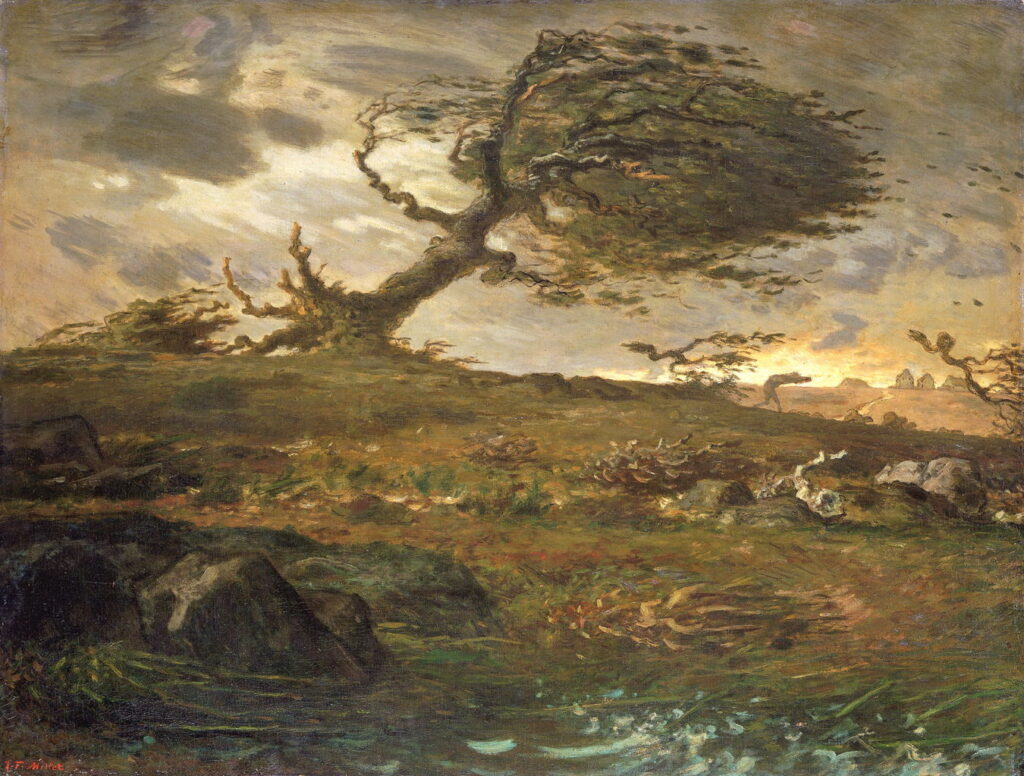A to Z of Landscapes: Wind

In this alphabet of landscape painting, we’ve covered two of the four ancient elements, in earth and various bodies of water, but not yet touched on air. Therefore the letter w is for wind, a real challenge to paint.
The most florid paintings of wind are in seascapes, where its effects are most immediate.
Joseph Mallord William Turner (1775–1851), Snow Storm, Steam Boat off a Harbour’s Mouth (1842), oil on canvas, 91.4 x 121.9 cm, The Tate Gallery (Accepted by the nation as part of the Turner Bequest 1856), London. Photographic Rights © Tate 2016, CC-BY-NC-ND 3.0 (Unported), http://www.tate.org.uk/art/artworks/turner-snow-storm-steam-boat-off-a-harbours-mouth-n00530
JMW Turner was one of the great masters of the shipwreck/storm maritime scene. My favourite example is this Snow Storm, Steam Boat off a Harbour’s Mouth (1842). This was the work for which it was claimed that Turner had himself lashed to the mast so that he could observe the storm properly, almost certainly false and quite unnecessary anyway: as a seasoned Channel traveller, Turner would have had ample previous experience. This also shows one of Turner’s most distinctive features in painting storms, the vortex, with his subject seen in its central eye. Although not exactly natural, it has proved atmospheric.
Peder Balke (1804–1887), The Harbor at Skjervøy (c 1844-46), oil on paper on cardboard, 12 x 17.5 cm, Private collection. The Athenaeum.
Peder Balke takes advantage of the rich clues provided in The Harbor at Skjervøy (c 1844-46). In this small fishing port in Troms, in the far north of Norway, the wind fills the sky with wheeling seabirds, heels the yachts, turns the sea white from breaking waves, and drives distant smoke almost horizontally.
Clarkson Frederick Stanfield (1793–1867), Oude Scheld – Texel Island, Looking towards Nieuwe Diep and the Zuider Zee (1844), oil and bitumen on canvas, 100.3 x 125.7 cm, The Tate Gallery (Presented by Robert Vernon 1847), London. © The Tate Gallery and Photographic Rights © Tate (2016), CC-BY-NC-ND 3.0 (Unported), http://www.tate.org.uk/art/artworks/stanfield-oude-scheld-texel-island-looking-towards-nieuwe-diep-and-the-zuider-zee-n00404
Clarkson Frederick Stanfield made his reputation from marine paintings showing the effects of wind and waves. In the summer of 1843, he toured the Netherlands, finding fresh motifs for his oil paintings, including Oude Scheld – Texel Island, Looking towards Nieuwe Diep and the Zuider Zee, completed in his studio the following year. Its fragmented clouds are paralleled by the frequent small waves, together building the effect of a brisk offshore breeze. The critics loved it.
Gustave Courbet (1819–1877), Autumn Sea (1867), oil on canvas, 54 x 73 cm, Ohara Museum of Art 大原美術館, Kurashiki, Japan. Wikimedia Commons.
Late in his career, Gustave Courbet’s coastal paintings came to concentrate on waves breaking on the beach, as in his Autumn Sea from 1867, where two sailing boats are the only forms to punctuate its horizon. They are heeling in the wind, which is also starting to blow the tops off the waves, as those dirty clouds scud rapidly across the sky.
On land, though, the painter has to work harder to convince the viewer, enlisting the help of trees and their foliage, and even washing hung out to dry.
Thomas Gainsborough (1727–1788), Landscape with Cottage and Church (1771-72), oil on canvas with some black chalk, 61.6 x 69.2, Yale Center for British Art, New Haven, CT. Wikimedia Commons.
Thomas Gainsborough’s sketchy Landscape with Cottage and Church (1771-72) is one of the first works to use angled highlights over the foliage of trees to make them appear as if they’re moving in the wind, and its style was far ahead of its time.
Charles-François Daubigny (1817–1878), October (date not known), oil on canvas, 87.5 × 160.5 cm, Rijksmuseum Amsterdam, Amsterdam. Wikimedia Commons.
Although trees are a help when depicting wind, Daubigny’s undated October manages very well with the tell-tale smoke rising from burning stubble.
Gustave Courbet (1819–1877), The Gust of Wind (c 1865), oil on canvas, 146.7 × 230.8 cm, Museum of Fine Arts, Houston, TX. Wikimedia Commons.
Gustave Courbet shows how a ‘leaning’ sky can amplify the windswept branches, in The Gust of Wind from about 1865.
Jean-François Millet (1814-1875), The Gust of Wind (1871-73), oil on canvas, 90.5 x 117.5 cm, National Museum of Wales / Amgueddfa Cymru, Cardiff, Wales. Wikimedia Commons.
Although it depicts more extreme conditions, Jean-François Millet’s Gust of Wind from 1871-73 must be the canonical painting of a storm. Its lone and distant figure is being blown almost double, as he’s nearly struck by a large branch torn from the tree to the left. Indeed, that tree is being uprooted, and its leaves pepper the storm sky at dawn.
Antônio Parreiras (1860–1937), Ventania (The Windstorm) (1888), oil on canvas, 150 × 100 cm, Pinacoteca do Estado de São Paulo, São Paulo, Brazil. Wikimedia Commons.
Antônio Parreiras’ wonderful Ventania (The Windstorm) (1888) is not as extreme, but just as eloquent, again using a leaning sky to accentuate the arcs formed by the trees.
Claude Monet (1840–1926), Poplars (Wind Effect) (1891), oil on canvas, 100 × 73.5 cm, Private collection. Wikimedia Commons.
With the Impressionist emphasis on transient effects of light rather than weather, their paintings tend to be more subtle again, as shown in Claude Monet’s Poplars (Wind Effect) from 1891.
Gustave Caillebotte (1848–1894), Laundry Drying, Petit Gennevilliers (1892), oil on canvas, 106 x 151 cm, Wallraf-Richartz-Museum. WikiArt.
Some of the most effective aids for the depiction of wind are flags and drying washing. While Sisley used the former, Gustave Caillebotte painted two views in which a washing line gives the strongest clue as to the wind. This is his Laundry Drying, Petit Gennevilliers (1892), the windier of the two.
Winslow Homer (1836–1910), Hurricane, Bahamas (1898), watercolor and graphite on wove paper, 36.7 × 53.5 cm, The Metropolitan Museum of Art, New York, NY. Wikimedia Commons.
Following his time at Cullercoats in England painting fisherfolk there, Winslow Homer’s simple and effective watercolour of Hurricane, Bahamas (1898) should come as no surprise.
Franz von Stuck (1863–1928), Storm Landscape (c 1920), oil on panel, 60 × 62.5 cm, Private collection. Wikimedia Commons.
Although not famous as a landscape painter, Franz von Stuck’s Storm Landscape (c 1920) leaves the viewer in no doubt.

